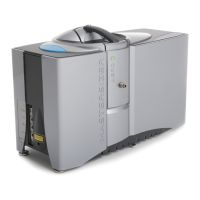Sample preparation guidance Chapter 6
Mastersizer 3000 Page 6-9
The obscuration and its behaviour during the dispersion of the sample can also
warn of other potential problems.
If the obscuration decreases the size of the particles within the sample may be
increasing; either the sample is sticking together or the particles are actually swell-
ing due to the dispersant. Other causes could be the larger particles settling out due
to inadequate pumping and stirring or even the particles dissolving.
If obscuration increases rapidly, particles may be attaching themselves to the cell
windows due to surface charges. This means material is in the laser beam continu-
ously and the obscuration appears to increase. To solve this, use an admixture.
Bubbles
The Mastersizer sees bubbles as particles and measures them. Bubbles vary in size
but are typically around 100 microns in size. In many cases these bubbles can be
seen clearly as a second and separate peak when the measurement data is analysed.
Always be wary of bubbles in the system.
When the dispersant has been added to the dispersion unit and circulated, we
advise stopping the unit briefly (using the Stop all operations button in the
Active Accessory control) to allow trapped air to escape the system. Also, during
installation, ensure there are no twists or loops in the connected sample tubing.
When adjusting the pump and stirrer speed for a particular sample, ensure the
speed is not so fast that it introduces air into the system.
When a surfactant is added to the sample, excessive speed of the stirrer/pump may
cause frothing. This will force bubbles into the system.
Degassing
If dispersant is stored under pressure or at low temperature, consider de-gassing
before use. The pressure release or temperature rise reduces the solubility of gases,
resulting in bubble formation in the pipes and tank etc. This is a problem with
some mains water supplies. The best answer is to store enough dispersant at room
temperature and pressure for several hours before use to allow de-gassing to occur.
For more information see Choice and preparation of the dispersant above.
Pulses of ultrasonics can help to degas the dispersant after the tank has been cleaned
and filled with fresh dispersant. To do this, use the Active accessory control
panel (Tools-Accessories) and then select Enable pulsed sonication.
Note
Ensure that all dispersants are degassed before being added to the system.

